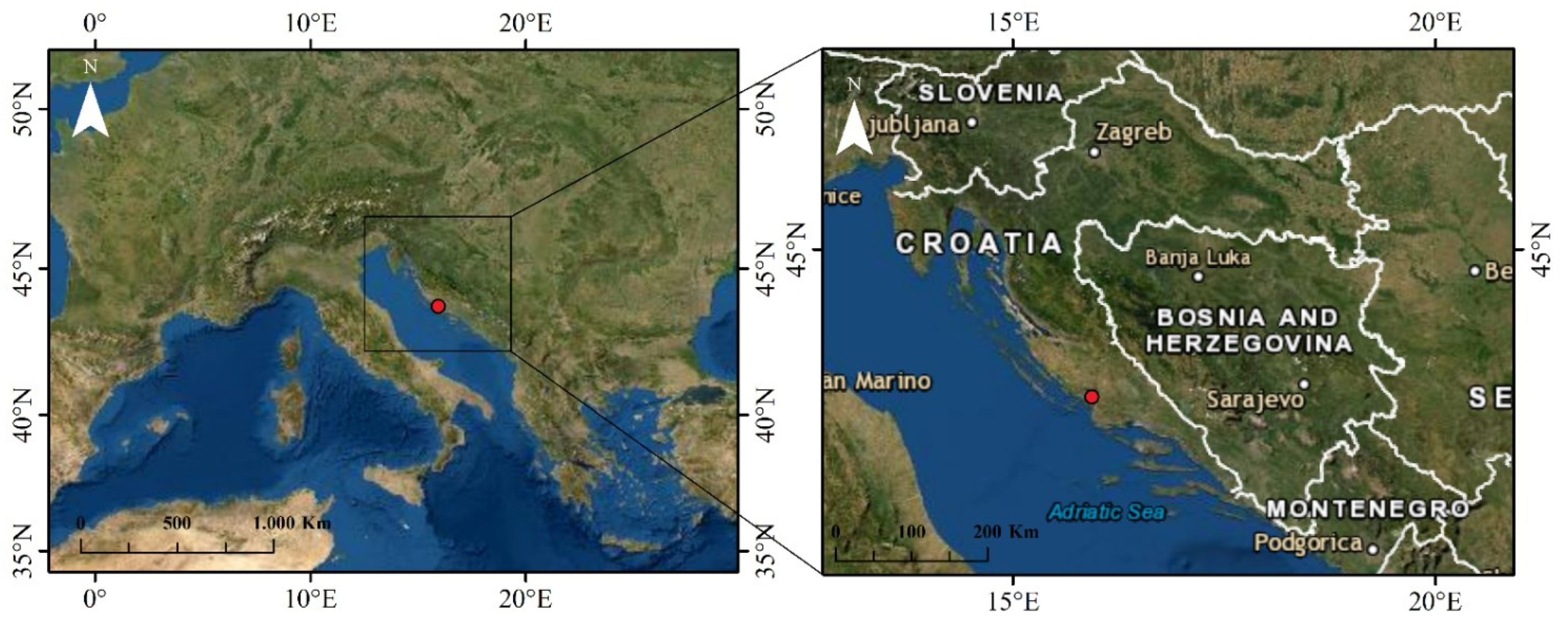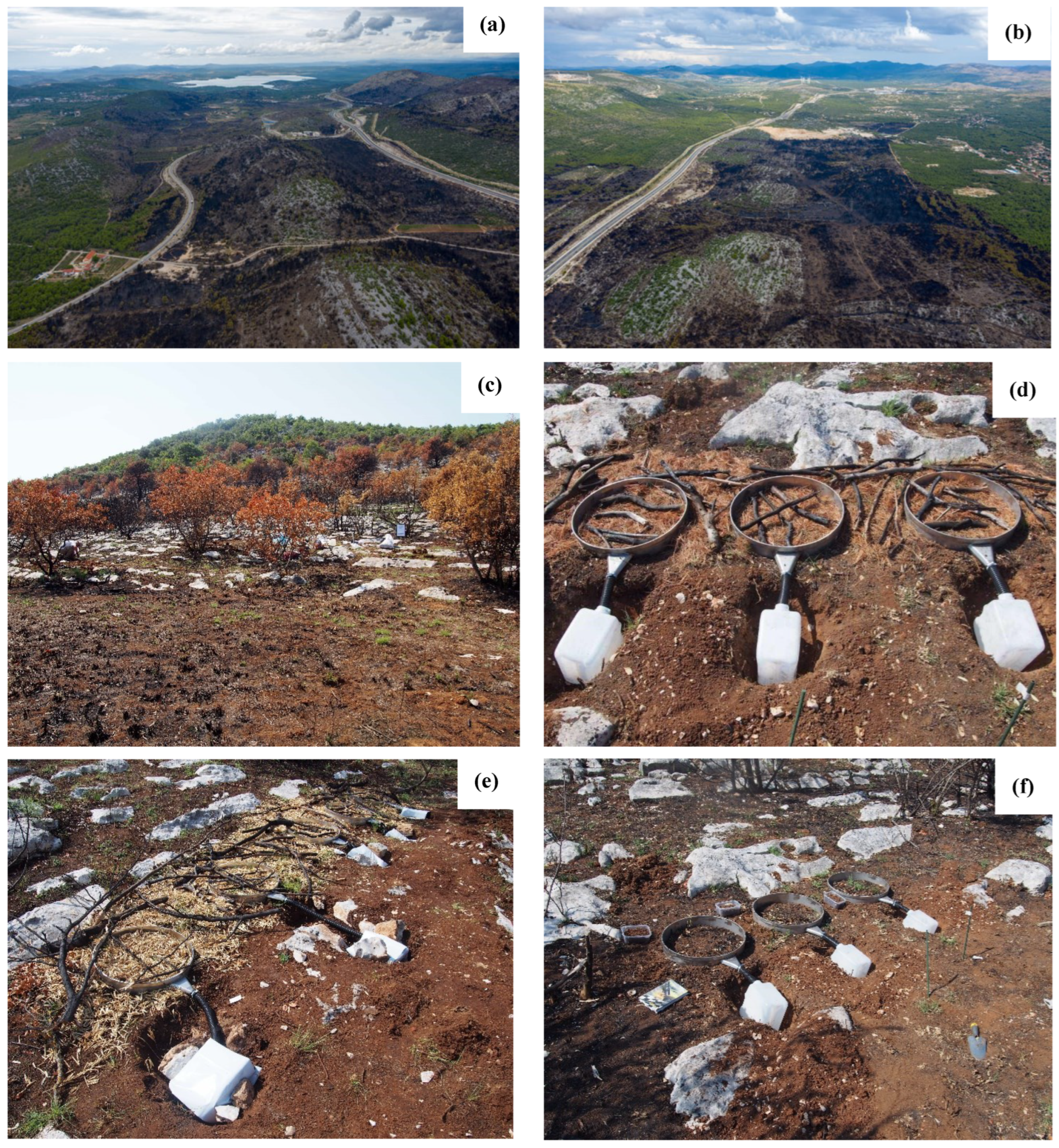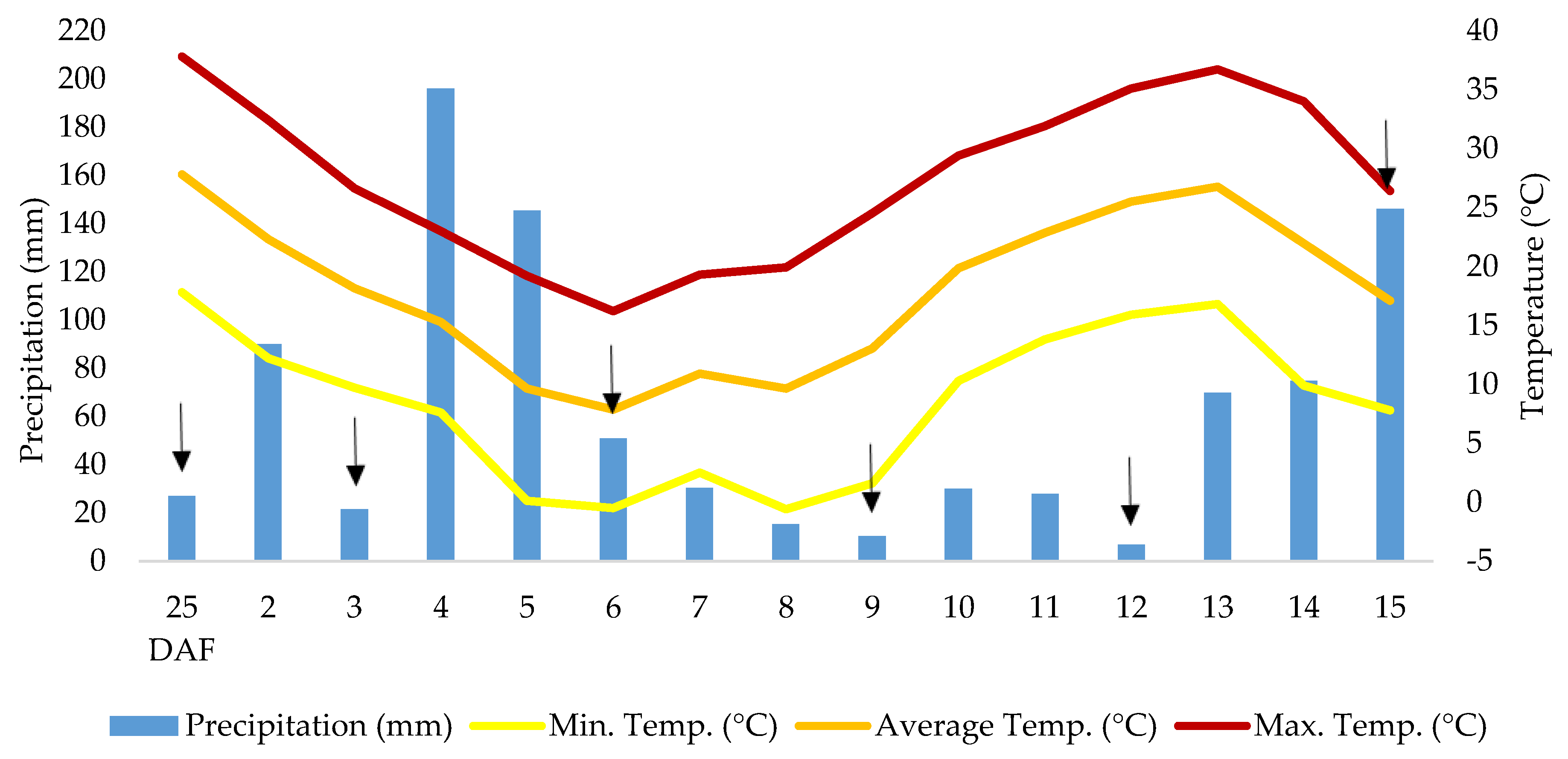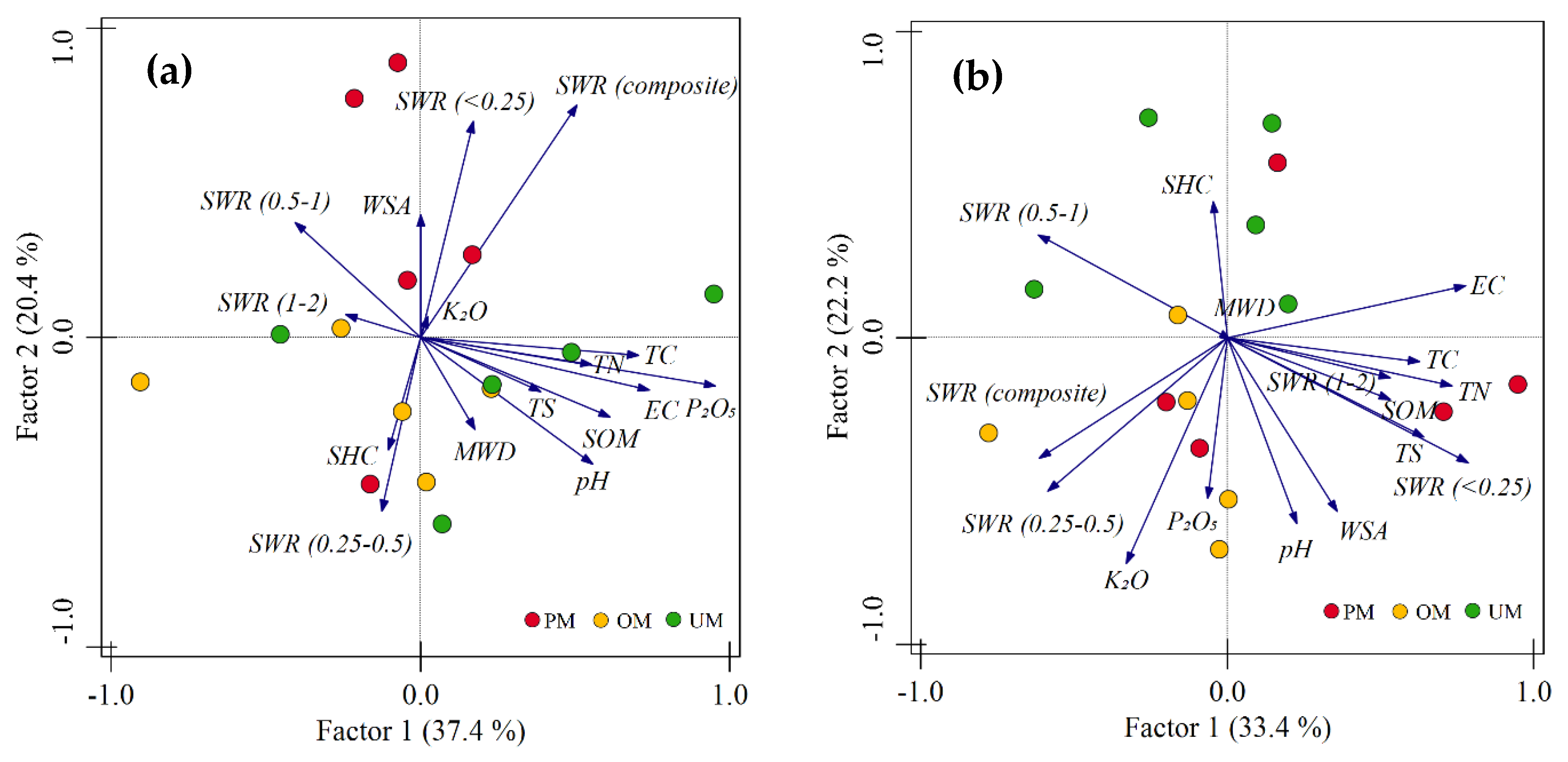Temporal Impact of Mulch Treatments (Pinus halepensis Mill. and Olea europaea L.) on Soil Properties after Wildfire Disturbance in Mediterranean Croatia
Abstract
:1. Introduction
2. Materials and Methods
2.1. Study Site
2.2. Experimental Design and Field Sampling
2.3. Soil Physical Analysis
2.4. Soil Chemical Analysis
2.5. Statistical Analysis
3. Results
3.1. Meteorological Observations
3.2. Soil Physical Properties
3.3. Soil Chemical Properties
4. Multivariate Analysis
5. Discussion
5.1. Soil Physical Properties
5.2. Soil Chemical Properties
6. Overall Discussion and Implications for Post-Fire Management
7. Conclusions
Author Contributions
Funding
Data Availability Statement
Acknowledgments
Conflicts of Interest
References
- Pausas, J.G.; Llovet, J.; Rodrigo, A.; Vallejo, R. Are Wildfires a Disaster in the Mediterranean Basin? A Review. Int. J. Wildl. Fire 2008, 17, 713–723. [Google Scholar] [CrossRef] [Green Version]
- Moreira, F.; Viedma, O.; Arianoutsou, M.; Curt, T.; Koutsias, N.; Rigolot, E.; Barbati, A.; Corona, P.; Vaz, P.; Xanthopoulos, G.; et al. Landscape—Wildfire Interactions in Southern Europe: Implications for Landscape Management. J. Environ. Manag. 2011, 92, 2389–2402. [Google Scholar] [CrossRef] [PubMed] [Green Version]
- Pausas, J.G.; Keeley, J.E. A Burning Story: The Role of Fire in the History of Life. Bioscience 2009, 59, 593–601. [Google Scholar] [CrossRef] [Green Version]
- Delač, D.; Kisić, I.; Bogunović, I.; Pereira, P. Temporal Impacts of Pile Burning on Vegetation Regrowth and Soil Properties in a Mediterranean Environment (Croatia). Sci. Total Environ. 2021, 799, 149318. [Google Scholar] [CrossRef] [PubMed]
- Delač, D.; Pereira, P.; Kisić, I. The Effects of Mulch (Olea Europea and Pinus Halepensis) on Burned Soils: A Preliminary Study in Adriatic Coast (Croatia). EGU Gen. Assem. 2020, 2020, 1295. [Google Scholar]
- Úbeda, X.; Mataix-Solera, J. Management of Fire-Affected Soils. In Fire Effects on Soil Properties; Pereira, P., Mataix-Solera, J., Ubeda, X., Rein, G., Artemi, C., Eds.; CSIRO Publishing: Collingwood, Australia, 2019; pp. 217–226. ISBN 978-1-48630-815-6. [Google Scholar]
- Turco, M.; Llasat, M.C.; von Hardenberg, J.; Provenzale, A. Climate Change Impacts on Wildfires in a Mediterranean Environment. Clim. Change 2014, 125, 369–380. [Google Scholar] [CrossRef]
- Pereira, P.; Brevik, E.; Bogunović, I.; Ferran, E.-S. Ash and Soils: A Close Relationship in Fire-Affected Areas. In Fire Effects on Soil Properties; Pereira, P., Mataix-Solera, J., Úbeda, X., Rein, G., Cerdà, A., Eds.; CSIRO Publishing: Collingwood, Australia, 2019; ISBN 978-1-48630-814-9. [Google Scholar]
- Hrelja, I.; Šestak, I.; Delač, D.; Pereira, P.; Bogunović, I. Soil Chemical Properties and Trace Elements after Wildfire in Mediterranean Croatia: Effect of Severity, Vegetation Type and Time-Since-Fire. Agronomy 2022, 12, 1515. [Google Scholar] [CrossRef]
- Prosdocimi, M.; Tarolli, P.; Cerdà, A. Mulching Practices for Reducing Soil Water Erosion: A Review. Earth Sci. Rev. 2016, 161, 191–203. [Google Scholar] [CrossRef]
- Robichaud, P.R.; Jordan, P.; Lewis, S.A.; Ashmun, L.E.; Covert, S.A.; Brown, R.E. Evaluating the Effectiveness of Wood Shred and Agricultural Straw Mulches as a Treatment to Reduce Post-Wildfire Hillslope Erosion in Southern British Columbia, Canada. Geomorphology 2013, 197, 21–33. [Google Scholar] [CrossRef]
- Díaz-Raviña, M.; Martín, A.; Barreiro, A.; Lombao, A.; Iglesias, L.; Díaz-Fierros, F.; Carballas, T. Mulching and Seeding Treatments for Post-Fire Soil Stabilisation in NW Spain: Short-Term Effects and Effectiveness. Geoderma 2012, 191, 31–39. [Google Scholar] [CrossRef]
- Gómez-Rey, M.X.; Couto-Vázquez, A.; García-Marco, S.; González-Prieto, S.J. Impact of Fire and Post-Fire Management Techniques on Soil Chemical Properties. Geoderma 2013, 195–196, 155–164. [Google Scholar] [CrossRef]
- Jonas, J.L.; Berryman, E.; Wolk, B.; Morgan, P.; Robichaud, P.R. Post-Fire Wood Mulch for Reducing Erosion Potential Increases Tree Seedlings with Few Impacts on Understory Plants and Soil Nitrogen. For. Ecol. Manag. 2019, 453, 117567. [Google Scholar] [CrossRef]
- Lucas-Borja, M.E.; González-Romero, J.; Plaza-Álvarez, P.A.; Sagra, J.; Gómez, M.E.; Moya, D.; Cerdà, A.; de las Heras, J. The Impact of Straw Mulching and Salvage Logging on Post-Fire Runoff and Soil Erosion Generation under Mediterranean Climate Conditions. Sci. Total Environ. 2019, 654, 441–451. [Google Scholar] [CrossRef] [PubMed]
- Bautista, S.; Bautista, S.; Robichaud, P.R.; Bladé, C. Post-Fire Mulching. In Fire Effects on Soils and Restoration Strategies; Cerda, A., Robichaud, P., Eds.; Science Publishers: Amsterdam, The Netherlands, 2009; pp. 353–372. ISBN 978-0-42906-359-6. [Google Scholar]
- Robichaud, P.R. Post-Fire Stabilization and Rehabilitation. In Fire Effects on Soils and Restoration Strategies; Cerdà, A., Robichaud, P.R., Eds.; CRC Press: Boca Raton, FL, USA, 2009; pp. 1–613. ISBN 978-1-43984-333-8. [Google Scholar]
- Kottek, M.; Grieser, J.; Beck, C.; Rudolf, B.; Rubel, F. World Map of the Köppen-Geiger Climate Classification Updated. Meteorol. Z. 2006, 15, 259–263. [Google Scholar] [CrossRef]
- IUSS-WRB. World Reference Base for Soil Resources. World Soil Resources Reports 106; Agriculture Organization for the United Nations: Rome, Italy, 2015; ISBN 978-9-25108-369-7. [Google Scholar]
- Delač, D.; Pereira, P.; Kisić, I. Impact of Post-Wildfire Stabilization Treatments on Major and Minor Topsoil Elements in a Mediterranean Environment (Croatia): First-Year Study. EGU Gen. Assem. 2021, 2021, 5194. [Google Scholar]
- Doerr, S.H.; Blake, W.H.; Shakesby, R.A.; Stagnitti, F.; Vuurens, S.H.; Humphreys, G.S.; Wallbrink, P. Heating Effects on Water Repellency in Australian Eucalypt Forest Soils and Their Value in Estimating Wildfire Soil Temperatures. Int. J. Wildl. Fire 2004, 13, 157–163. [Google Scholar] [CrossRef]
- Robichaud, P.R.; Lewis, S.A.; Ashmun, L.E. New Procedure for Sampling Infiltration to Assess Post-Fire Soil Water Repellency. USDA For. Serv. Res. Note RMRS-RN 2008, 14, 33. [Google Scholar] [CrossRef] [Green Version]
- Walkley, A.; Black, I.A. An Examination of the Degtjareff Method for Determining Soil Organic Matter, and a Proposed Modification of the Chromic Acid Titration Method. Soil Sci. 1934, 37, 29–38. [Google Scholar] [CrossRef]
- Delač, D.; Pereira, P.; Bogunović, I.; Kisić, I. Short-Term Effects of Pile Burn on N Dynamic and N Loss in Mediterranean Croatia. Agronomy 2020, 10, 1340. [Google Scholar] [CrossRef]
- Delač, D.; Kisić, I.; Zgorelec, Ž.; Perčin, A.; Pereira, P. Slash-Pile Burning Impacts on Water Quality in a Mediterranean Environment (Croatia). Catena 2022, 218, 14. [Google Scholar] [CrossRef]
- Certini, G. Effects of Fire on Properties of Forest Soils: A Review. Oecologia 2005, 143, 1–10. [Google Scholar] [CrossRef]
- Mataix-Solera, J.; Doerr, S.H. Hydrophobicity and Aggregate Stability in Calcareous Topsoils from Fire-Affected Pine Forests in Southeastern Spain. Geoderma 2004, 118, 77–88. [Google Scholar] [CrossRef]
- Arcenegui, V.; Jiménez-Morillo, N.T.; Jiménez-Pinilla, P. Soil Water Repellency. In Fire Effects on Soil Properties; Pereira, P., Mataix-Solera, J., Úbeda, X., Rein, G., Cerdà, A., Eds.; CSIRO Publishing: Collingwood, Australia, 2019; pp. 81–87. [Google Scholar]
- Cerdà, A.; Robichaud, P.R. Fire Effects on Soil Infiltration. In Fire Effects on Soils and Restoration Strategies; Cerda, A., Robichaud, P., Eds.; Science Publishers: Amsterdam, The Netherlands, 2009; Volume 34, pp. 81–103. ISBN 978-1-43984-333-8. [Google Scholar]
- Lucas-Borja, M.E.; Zema, D.A.; Carrà, B.G.; Cerdà, A.; Plaza-Alvarez, P.A.; Cózar, J.S.; Gonzalez-Romero, J.; Moya, D.; de las Heras, J. Short-Term Changes in Infiltration between Straw Mulched and Non-Mulched Soils after Wildfire in Mediterranean Forest Ecosystems. Ecol. Eng. 2018, 122, 27–31. [Google Scholar] [CrossRef] [Green Version]
- Velasco, A.; Úbeda, X. Estabilidad de Los Agregados de Un Suelo Quemado a Diferentes Intensidades de Fuego Dieciocho Años Después de Un Incendio Forestal. Cuad. Investig. Geogr. 2014, 40, 333–352. [Google Scholar] [CrossRef] [Green Version]
- Mulumba, L.N.; Lal, R. Mulching Effects on Selected Soil Physical Properties. Soil Tillage Res. 2008, 98, 106–111. [Google Scholar] [CrossRef]
- González-Pérez, J.A.; González-Vila, F.J.; Almendros, G.; Knicker, H. The Effect of Fire on Soil Organic Matter—A Review. Environ. Int. 2004, 30, 855–870. [Google Scholar] [CrossRef]
- Mataix-Solera, J.; Cerdà, A.; Arcenegui, V.; Jordán, A.; Zavala, L.M. Fire Effects on Soil Aggregation: A Review. Earth-Sci. Rev. 2011, 109, 44–60. [Google Scholar] [CrossRef]
- Jordán, A.; Zavala, L.M.; Muñoz-Rojas, M. Mulching, Effects on Soil Physical Properties. In Encyclopedia of Earth Sciences Series; Springer: Dordrecht, The Netherlands, 2011; Volume 4, pp. 492–496. [Google Scholar]
- Hadas, A.; Rawitz, E.; Etkin, H.; Margolin, M. Short-Term Variations of Soil Physical Properties as a Function of the Amount and C/N Ratio of Decomposing Cotton Residues. I. Soil Aggregation and Aggregate Tensile Strength. Soil Tillage Res. 1994, 32, 183–198. [Google Scholar] [CrossRef]
- Pereira, P.; Cerdà, A.; Martin, D.; Úbeda, X.; Depellegrin, D.; Novara, A.; Martínez-Murillo, J.F.; Brevik, E.C.; Menshov, O.; Rodrigo Comino, J.; et al. Short-Term Low-Severity Spring Grassland Fire Impacts on Soil Extractable Elements and Soil Ratios in Lithuania. Sci. Total Environ. 2017, 578, 469–475. [Google Scholar] [CrossRef] [Green Version]
- Ruiz Sinoga, J.D.; Pariente, S.; Diaz, A.R.; Martinez Murillo, J.F. Variability of Relationships between Soil Organic Carbon and Some Soil Properties in Mediterranean Rangelands under Different Climatic Conditions (South of Spain). Catena 2012, 94, 17–25. [Google Scholar] [CrossRef]
- Lasanta, T.; Cerdà, A. Long-Term Erosional Responses after Fire in the Central Spanish Pyrenees: 2. Solute Release. Catena 2005, 60, 81–100. [Google Scholar] [CrossRef]
- Hueso-González, P.; Martínez-Murillo, J.F.; Ruiz-Sinoga, J.D. The Impact of Organic Amendments on Forest Soil Properties under Mediterranean Climatic Conditions. Land Degrad. Dev. 2014, 25, 604–612. [Google Scholar] [CrossRef]
- Guang-Ming, L.; Jing-Song, Y.; Rong-Jiang, Y. Electrical Conductivity in Soil Extracts: Chemical Factors and Their Intensity. Pedosphere 2006, 16, 100–107. [Google Scholar] [CrossRef]
- Lucas-Borja, M.E.; Plaza-Álvarez, P.A.; Ortega, R.; Miralles, I.; González-Romero, J.; Sagra, J.; Moya, D.; Zema, D.A.; de las Heras, J. Short-Term Changes in Soil Functionality after Wildfire and Straw Mulching in a Pinus Halepensis M. Forest. For. Ecol. Manag. 2020, 457, 117700. [Google Scholar] [CrossRef]
- Nam, A.M.; Tomi, F.; Gibernau, M.; Casanova, J.; Bighelli, A. Composition and Chemical Variability of the Needle Oil from Pinus Halepensis Growing in Corsica. Chem. Biodivers. 2016, 13, 380–386. [Google Scholar] [CrossRef] [PubMed]
- Acar-Tek, N.; Aǧagündüz, D. Olive Leaf (Olea Europaea L. Folium): Potential Effects on Glycemia and Lipidemia. Ann. Nutr. Metab. 2020, 76, 10–15. [Google Scholar] [CrossRef]
- Huang, Z.; Xu, Z.; Chen, C. Effect of Mulching on Labile Soil Organic Matter Pools, Microbial Community Functional Diversity and Nitrogen Transformations in Two Hardwood Plantations of Subtropical Australia. Appl. Soil Ecol. 2008, 40, 229–239. [Google Scholar] [CrossRef]
- Neary, D.G.; Ryan, K.C.; DeBano, L.F. Wildland Fire in Ecosystems: Effects of Fire on Soils and Water; Gen. Tech. Rep. RMRS-GTR-42-vol.4; US Department of Agriculture, Forest Service, Rocky Mountain Research Station: Ogden, UT, USA, 2005.
- Sas-Paszt, L.; Pruski, K.; Zurawicz, E.; Sumorok, B.; Derkowska, E.; Głuszek, S. The Effect of Organic Mulches and Mycorrhizal Substrate on Growth, Yield and Quality of Gold Milenium Apples on M.9 Rootstock. Can. J. Plant Sci. 2014, 94, 281–291. [Google Scholar] [CrossRef]
- Ekinci, H.; Kavdir, Y. Changes in Soil Quality Parameters after a Wildfire in Gelibolu (Gallipoli) National Park, Turkey. Fresenius Environ. Bull. 2005, 14, 1152–1218. [Google Scholar]
- Gómez-Rey, M.X.; González-Prieto, S.J. Short and Medium-Term Effects of a Wildfire and Two Emergency Stabilization Treatments on the Availability of Macronutrients and Trace Elements in Topsoil. Sci. Total Environ. 2014, 493, 251–261. [Google Scholar] [CrossRef] [Green Version]
- Francos, M.; Pereira, P.; Alcañiz, M.; Mataix-Solera, J.; Úbeda, X. Impact of an Intense Rainfall Event on Soil Properties Following a Wildfire in a Mediterranean Environment (North-East Spain). Sci. Total Environ. 2016, 572, 1353–1362. [Google Scholar] [CrossRef] [PubMed]
- Soler-Rivas, C.; Espiń, J.C.; Wichers, H.J. Oleuropein and Related Compounds. J. Sci. Food Agric. 2000, 80, 1013–1023. [Google Scholar] [CrossRef]





| Soil Fraction | T | Sampling Date | F | |||||
|---|---|---|---|---|---|---|---|---|
| 25 DAF | 3 MAF | 6 MAF | 9 MAF | 12 MAF | 15 MAF | p | ||
| Composite | PM | 3 ± 1.1Aa | 1.8 ± 0.75ABb | 1.8 ± 0.75ABb | 1.4 ± 0.49Bb | 1 ± 0.63Bb | 1.3 ± 0.4Bb | *** |
| OM | 1.8 ± 0.75 | 2.1 ± 0.63 | 1.6 ± 0.8 | 1.8 ± 0.75 | 1.4 ± 0.49 | 1.4 ± 0.49 | n.s. | |
| UM | 2.4 ± 1.02 | 1.8 ± 0.75 | 1.8 ± 0.75 | 1.8 ± 0.75 | 1.8 ± 0.75 | 1.4 ± 0.49 | n.s. | |
| K-W p | n.s. | n.s. | n.s. | n.s. | n.s. | n.s. | ||
| 1–2 mm | PM | 1.4 ± 049 | 2.1 ± 0.63 | 1.8 ± 0.75 | 1.1 ± 0.7 | 1.4 ± 0.49 | 1.4 ± 0.49 | n.s. |
| OM | 1.8 ± 0.4 | 1.2 ± 0.4 | 1.8 ± 0.4 | 1.4 ± 0.8 | 1.6 ± 0.49 | 1.6 ± 0.49 | n.s. | |
| UM | 1.4 ± 0.49 | 1.6 ± 0.49 | 1.8 ± 0.75 | 1.4 ± 0.49 | 2.2 ± 0.75 | 1.2 ± 0.4 | n.s. | |
| K-W p | n.s. | n.s. | n.s. | n.s. | n.s. | n.s. | ||
| 0.5–1 mm | PM | 6.23 ± 1.64Aa | 1.33 ± 0.63Bb | 1.8 ± 0.75Bb | 1.4 ± 0.49Bb | 1.4 ± 0.49Bb | 1.4 ± 0.49Bb | * |
| OM | 4.33 ± 1.26Aa | 1.33 ± 0.63Bb | 1.8 ± 0.4ABab | 1.6 ± 0.49ABab | 1.6 ± 0.49ABab | 1.6 ± 0.49ABab | * | |
| UM | 3.39 ± 1.07A | 1.8 ± 0.75AB | 1.8 ± 0.75AB | 1.5 ± 0.45B | 2.2 ± 0.75AB | 1.86 ± 0.74AB | n.s. | |
| K-W p | n.s. | n.s. | n.s. | n.s. | n.s. | n.s. | ||
| 0.25–0.5 | PM | 25.82 ± 13.89Aa | 4.4 ± 1.85Bb | 1.8 ± 0.62Bb | 2.4 ± 0.25Bb | 1.65 ± 0.25Bb | 2.4 ± 0.25Bb | *** |
| mm | OM | 23.34 ± 0.43Aa | 4.47 ± 1.04Bb | 1.73 ± 0.33Bb | 1.73 ± 0.33Bb | 1.92 ± 1.51Bb | 2.93 ± 1.51Bb | *** |
| UM | 21.56 ± 2.14Aa | 3.65 ± 1.32Bb | 1.73 ± 0.44Bb | 1.01 ± 0.31Bb | 1.73 ± 0.44Bb | 1.07 ± 0.13Bb | *** | |
| K-W p | n.s. | n.s. | n.s. | n.s. | n.s. | n.s. | ||
| <0.25 mm | PM | 38.75 ± 18.83Aa | 6.15 ± 1.83Bb | 1.95 ± 0.76Bb | 2.07 ± 1.04Bb | 2.67 ± 0.76Bb | 2.87 ± 0.69Bb | *** |
| OM | 23.25 ± 2.27Aa | 3.39 ± 1.41Bb | 2.19 ± 0.43Bb | 2.2 ± 0.4Bb | 2.07 ± 0.83Bb | 2.67 ± 0.92Bb | *** | |
| UM | 28.8 ± 4.96Aa | 3.05 ± 0.77Bb | 1.93 ± 0.61Bb | 2.2 ± 0.75Bb | 1.73 ± 0.33Bb | 1.4 ± 0.49Bb | *** | |
| K-W p | ** | n.s. | n.s. | n.s. | * | * | ||
| Variable | T | Sampling Date | F | |||||
|---|---|---|---|---|---|---|---|---|
| 25 DAF | 3 MAF | 6 MAF | 9 MAF | 12 MAF | 15 MAF | p | ||
| SHC | PM | 3.53 × 10−4AB | 2.81 × 10−4Bb | 5.84 × 10−4AB | 5.51 × 10−4ABb | 7.31 × 10−4Aa | 7.54 × 10−4Aab | ** |
| (mm h−1) | OM | 3.93 × 10−4AB | 3.06 × 10−4Bab | 6.49 × 10−4AB | 5.32 × 10−4ABb | 7.96 × 10−4Aa | 8.87 × 10−4Aa | * |
| UM | 4.03 × 10−4B | 5.23 × 10−4ABa | 4.48 × 10−4B | 9.93 × 10−5Aa | 5.37 × 10−4ABb | 4.46 × 10−5Bb | ** | |
| K-W p | n.s. | * | n.s. | * | * | * | ||
| Variable | T | Sampling Date | F | |||||
|---|---|---|---|---|---|---|---|---|
| 25 DAF | 3 MAF | 6 MAF | 9 MAF | 12 MAF | 15 MAF | p | ||
| MWD | PM | 1.92 ± 0.24Ca | 2.32 ± 0.12ABCa | 2.83 ± 0.5Aa | 2.66 ± 0.35Aa | 2.57 ± 0.19ABCa | 2.78 ± 0.21Aa | *** |
| (mm) | OM | 1.96 ± 0.19Ba | 2.28 ± 0.31ABa | 2.83 ± 0.25Aa | 2.69 ± 0.34Aa | 2.44 ± 0.45ABa | 2.67 ± 0.13Aab | *** |
| UM | 2.25 ± 0.07ABa | 2.32 ± 0.29Aa | 2.05 ± 0.1ABb | 2.46 ± 0.18Aa | 1.71 ± 0.09BCb | 1.38 ± 0.55Cb | *** | |
| K-W p | n.s. | n.s. | * | n.s. | * | ** | ||
| WSA | PM | 50.02 ± 0.18Ca | 52.21 ± 0.79Ba | 53.93 ± 0.82Aa | 55.46 ± 7.28Aa | 54.4 ± 1.48Aab | 55.47 ± 0.63Aa | *** |
| (%) | OM | 49.59 ± 0.3Bb | 52.79 ± 1.86ABa | 56.55 ± 4.48Aa | 56.94 ± 2Aa | 55.13 ± 1.9Aa | 55.1 ± 1.57Aa | *** |
| UM | 49.93 ± 0.1Cab | 52.61 ± 3.21ABa | 55.86 ± 1.78Aa | 50.76 ± 0.77Cb | 48.9 ± 3BCb | 50.91 ± 0.76BCb | *** | |
| K-W p | * | n.s. | n.s. | * | * | ** | ||
| Variable | T | Sampling Date | ||||||
|---|---|---|---|---|---|---|---|---|
| 25 DAF | 3 MAF | 6 MAF | 9 MAF | 12 MAF | 15 MAF | p | ||
| pH | PM | 6.57 ± 0.2B | 6.95 ± 0.1A | 6.15 ± 0.19C | 6.34 ± 0.21BC | 6.43 ± 0.1BC | 6.93 ± 0.14A | 3 *** |
| OM | 6.71 ± 0.11BC | 6.93 ± 0.05AB | 6.6 ± 0.1C | 6.49 ± 0.1C | 6.7 ± 0.21BC | 6.97 ± 0.08A | 3 *** | |
| UM | 6.8 ± 0.37ABb | 6.8 ± 0.16ABb | 6.35 ± 0.35B | 6.33 ± 0.35B | 6.66 ± 0.14AB | 7.00 ± 0.3A | 3 * | |
| K-W p | 2 n.s. | 2 n.s. | 2 n.s. | 2 n.s. | 2 n.s. | 2 n.s. | ||
| EC | PM | 203 ± 24Aa | 198 ± 18Aa | 144 ± 27Bab | 114 ± 14BCa | 85 ± 2.7Ca | 188 ± 6.43Aa | 3 *** |
| (μS cm−1) | OM | 200 ± 16Aa | 191 ± 12Aa | 153 ± 14Ba | 123 ± 15Ca | 73 ± 6Dab | 154 ± 20.6Ba | 3 *** |
| UM | 258 ± 64Aa | 194 ± 27Aa | 112 ± 11Bb | 107 ± 52Ba | 63 ± 2.6Cb | 130 ± 44.4Bb | 3 *** | |
| K-W p | 2 n.s. | 2 n.s. | 2 * | 2 n.s. | 2 ** | 2 ** | ||
| SOM | PM | 8.34 ± 1.13Aab | 6.32 ± 1.26Ba | 6.28 ± 0.23Ba | 6.60 ± 0.48ABa | 6.85 ± 0.64ABab | 6.96 ± 0.38ABa | 1 *** |
| (%) | OM | 7.27 ± 1.3Ab | 6.46 ± 0.95ABa | 6.24 ± 0.54Ba | 6.67 ± 0.16ABa | 7.06 ± 0.7Aa | 6.85 ± 0.41ABa | 1 * |
| UM | 9.10 ± 1.42Aa | 6.19 ± 0.43Ba | 4.59 ± 0.77Ba | 5.39 ± 0.61Ba | 5.56 ± 0.51Bb | 4.68 ± 0.45Bb | 1 * | |
| p | 1 *** | |||||||
| TS | PM | 0.11 ± 0.01Aa | 0.08 ± 0.01Ba | 0.06 ± 0.01Ca | 0.09 ± 0.01Ba | 0.11 ± 0.02Aa | 0.11 ± 0.02Aa | 1 ** |
| (%) | OM | 0.11 ± 0.01Aa | 0.08 ± 0.01Ba | 0.04 ± 0.01Ca | 0.09 ± 0.01ABa | 0.09 ± 0.01ABa | 0.09 ± 0.01ABa | 1 ** |
| UM | 0.11 ± 0.01Aa | 0.07 ± 0.01Ba | 0.05 ± 0.01Ca | 0.09 ± 0.01Ba | 0.09 ± 0.01Bb | 0.09 ± 0.01Ba | 1 ** | |
| K-W p | 1 *** | |||||||
| TC | PM | 5.92 ± 0.62ABCa | 5.19 ± 0.97BCa | 4.54 ± 0.17Ca | 5.68 ± 0.84ABCa | 6.64 ± 0.61ABa | 6.72 ± 0.13Aa | 1 ** |
| (%) | OM | 5.16 ± 0.6Aa | 5.02 ± 0.93ABa | 3.65 ± 0.25Ba | 5.05 ± 0.75ABab | 5.74 ± 0.47Aa | 6.14 ± 0.28Aab | 1 ** |
| UM | 5.82 ± 0.97Aa | 4.80 ± 0.19ABCa | 3.42 ± 0.21Ca | 4.11 ± 0.64BCb | 5.31 ± 0.35ABa | 4.51 ± 0.35ABCb | 1 *** | |
| 1 *** | ||||||||
| TN | PM | 0.5 ± 0.06 | 0.47 ± 0.11 | 0.42 ± 0.04 | 0.47 ± 0.07 | 0.55 ± 0.06 | 0.55 ± 0.06 | 1 n.s. |
| (%) | OM | 0.45 ± 0.04 | 0.42 ± 0.06 | 0.41 ± 0.02 | 0.45 ± 0.08 | 0.47 ± 0.03 | 0.47 ± 0.03 | 1 n.s. |
| UM | 0.47 ± 0.08 | 0.4 ± 0.01 | 0.44 ± 0.04 | 0.39 ± 0.09 | 0.45 ± 0.02 | 0.45 ± 0.02 | 1 n.s. | |
| 1 n.s. | ||||||||
| P2O5 | PM | 2.33 ± 0.49BCa | 6.64 ± 0.84Aa | 0.89 ± 0.74Ca | 1.12 ± 0.89Ca | 2.29 ± 0.94Bb | 3.74 ± 0.32Bab | 3 *** |
| (mg/kg) | OM | 2.52 ± 1.64Ba | 7.79 ± 1.32Aa | 1.49 ± 1.29Ba | 3.84 ± 5.11Aba | 3.69 ± 0.72ABa | 4.31 ± 0.33Aba | 3 *** |
| UM | 422 ± 2.37Aa | 6.83 ± 2.22Aa | 2.03 ± 1.05Aa | 3.89 ± 4.26Aa | 3.03 ± 0.38Aab | 2.96 ± 0.56Ab | 3 n.s. | |
| K-W p | 2 n.s. | 2 n.s. | 2 n.s. | 2 n.s. | 2 * | 2 ** | ||
| K2O | PM | 44.94 ± 4.3ABa | 51.1 ± 11.66Ab | 28.85 ± 3.11Ca | 29.69 ± 2.83Cab | 36.17 ± 3.36BCa | 41.4 ± 2.27ABab | 3 *** |
| (mg/kg) | OM | 44.2 ± 9.49BCa | 90.71 ± 8.89Aa | 30.78 ± 8.22Ca | 41.05 ± 7.64BCa | 45.88 ± 6.65BCa | 49.02 ± 5.64Ba | 3 *** |
| UM | 45.85 ± 9.62ABa | 47.36 ± 4.94Ab | 30.7 ± 4.06Ca | 27.92 ± 3.51Cb | 38.31 ± 3.8ABCa | 24.62 ± 5.52BCb | 3 *** | |
| K-W p | 2 n.s. | 2 ** | 2 n.s. | 2 * | 2 n.s. | 2 * | ||
Publisher’s Note: MDPI stays neutral with regard to jurisdictional claims in published maps and institutional affiliations. |
© 2022 by the authors. Licensee MDPI, Basel, Switzerland. This article is an open access article distributed under the terms and conditions of the Creative Commons Attribution (CC BY) license (https://creativecommons.org/licenses/by/4.0/).
Share and Cite
Delač, D.; Kisić, I.; Pereira, P. Temporal Impact of Mulch Treatments (Pinus halepensis Mill. and Olea europaea L.) on Soil Properties after Wildfire Disturbance in Mediterranean Croatia. Agronomy 2022, 12, 2484. https://doi.org/10.3390/agronomy12102484
Delač D, Kisić I, Pereira P. Temporal Impact of Mulch Treatments (Pinus halepensis Mill. and Olea europaea L.) on Soil Properties after Wildfire Disturbance in Mediterranean Croatia. Agronomy. 2022; 12(10):2484. https://doi.org/10.3390/agronomy12102484
Chicago/Turabian StyleDelač, Domina, Ivica Kisić, and Paulo Pereira. 2022. "Temporal Impact of Mulch Treatments (Pinus halepensis Mill. and Olea europaea L.) on Soil Properties after Wildfire Disturbance in Mediterranean Croatia" Agronomy 12, no. 10: 2484. https://doi.org/10.3390/agronomy12102484









